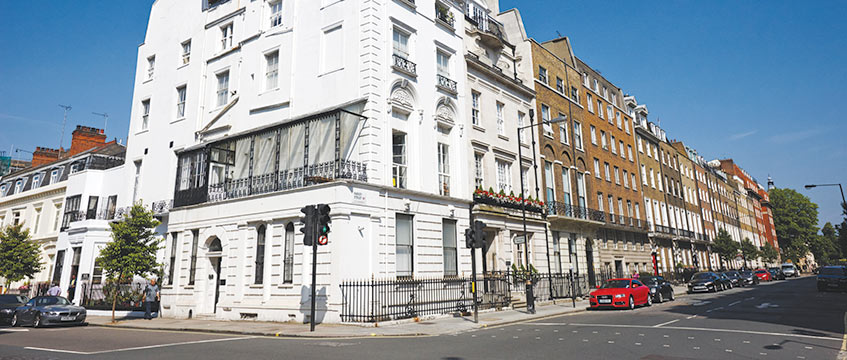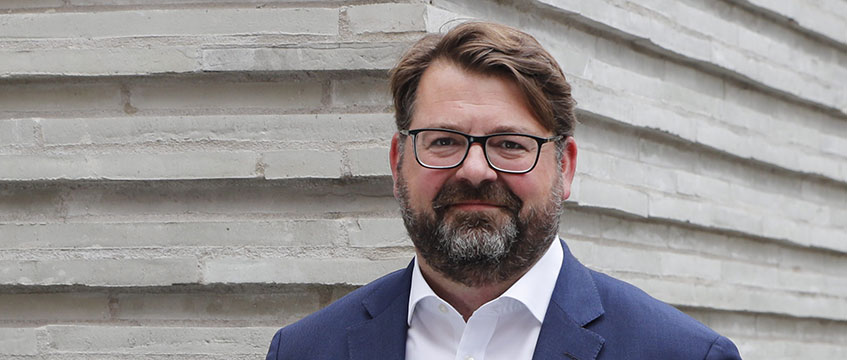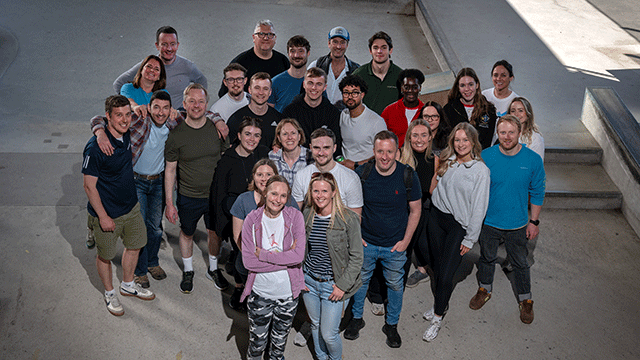The man whose Marylebone empire includes Harley Street is prescribing change. Pop-up shops and shared office space are among a range of treatments.
It’s barely eight months since Andrew Hynard took over the running of one of London’s most beautiful landholdings. As chief executive of the Howard de Walden Estate, stewardship of 92 acres in and around Marylebone falls to him and his team.
A veteran of 32 years at JLL, Hynard was never going to rip up the rulebook on arrival. Indeed, his longevity, stability and focus on the long term were precisely the characteristics that drove headhunter Odgers Berndtson to beat a path to his door.
But don’t think for a moment that Hynard simply plans to stand still. His priorities for a £4bn portfolio that includes Harley Street and Marylebone High Street will see the estate embrace the changes sweeping the wider real estate sector, and do so quickly.
It was just before Christmas 2016 that Hynard’s head was turned. He was vice chairman of JLL’s UK business, an enviable role which saw him dealing with firm’s big clients and offering something of a GP’s surgery to the business – lending an experienced hand to hiring, mentoring and ensuring colleagues were doing the right thing.
“It was almost being the conscience of the firm,” he says. “At JLL the conscience for me was very much around colleagues, people, the way we treated clients as well, interaction with clients, behaving properly, integrity, all those sorts of values.”
You can see why a 300-year-old estate, 100% owned by the Howard de Walden family, considered him the man to succeed Toby Shannon.
By October last year his feet were under his new desk, with a teapot, tea cosy and biscuit tin on top. Sat in his own office for the first time in his career, his instinct was to hold off on radical change. It still is. “Coming from an advisory consultancy business, you just get to understand how important service is, getting feedback and excellence, so on that score I think we’ll be getting better at the way we interact with tenants and occupiers,” he says.
“The one thing that resonated and stuck with me is that in a long-term business, such as the London estates, for example, you take your time, you don’t act hastily, you consider, reflect.
“One of the luxuries we’ve got without external shareholders, without a public treadmill of share price and annual performance, is that
we can take a medium and longer-term view.”
Vital change
But even the most avowed advocates of strength and stability recognise that change is vital, too.
“We can make some changes and, frankly, you’ve got to, otherwise you stand still and you’re dead,” he says.
He points to how much the estate changed under his two predecessors as evidence that his is no sleepy backwater.
“The shopfront of the estate is Marylebone High Street. Those of us who were working in the West End in the 1980s and 1990s will remember it,” he says.
“There were a lot of charity shops, it was pretty empty and Andrew Ashenden, who was Toby Shannon’s predecessor, really just saw the opportunity, with some good retail agency advice, to attract independent retailers. The rents, of course, were peanuts then.
“The transformational retailer that came was Waitrose. On the back of that they built a great blend of retailers and it became a great destination.
In its time that was a pretty radical evolution.”
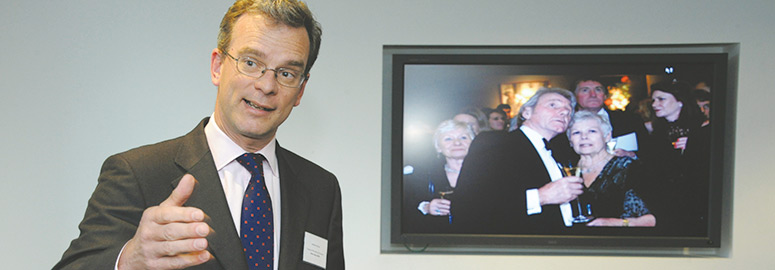
Now Hynard is planning something of a revolution of his own. Pop-ups, collaborative workspaces and better digital connectivity are high on his agenda. Walk around Marylebone today and you’ll see G.Network installing ultrafast fibre connectivity.
“We’re finding some solutions where we can do a section of a street at a time without too much disruption,” he says. “Broadband speed is
a huge frustration, from the feedback we get.”
Next up are a number of pop-up shops at the bottom of Marylebone Lane. Crossrail-related redevelopment is rife and Hynard sees it as an opportunity, with agent CWM, to offer short lets and increase the diversity of the offer at the same time.
“We’re looking at new, independent fledgling retailers who will have to put up with the disruption in return for below market-level rent.”
And then there is a collaborative office space. Howard de Walden currently runs one flexible office, though it’s more quaint and old-fashioned than slick and contemporary. Hynard would like to change that and draw a modern operator to the estate.
However, it’s all about striking the right mix. Medical is a major part of the estate’s offer (see box) and while Hynard wants to ensure it doesn’t dominate, he does want to continue to bring in “cutting-edge” medical services.
Future-proofing
As a significant central London landlord, Hynard is active in discussions around air quality and the pedestrianisation of Oxford Street. He can see benefits in rerouting buses to Wigmore Street as long as they are “the right type of buses”. Electric and smart, they could bring shoppers on to his streets without adding to air pollution.
Perhaps the project that excites Hynard most, though,
is the redevelopment of the
0.8-acre Moxon Street car park site, where Westminster
council granted planning permission for a mixed-use scheme comprising residential and around 45,000 sq ft of retail space.
As talks continue with the developer, he describes this as a “cracking opportunity”.
“Ridgeford has plans for a mixed-use scheme with a lot of residential but, importantly, some commercial and retail space, which will help extend that offer I was talking about,” he says.
“Hopefully they won’t rent it at exorbitant rents so we can have the benefit of more independent style and different retailers. But, yes, that will make a big difference. It’s a big project and it will take several years to come to fruition but hopefully we’ll see the benefits of that during my tenure.”
Why its Harley Street properties are just what the doctor ordered
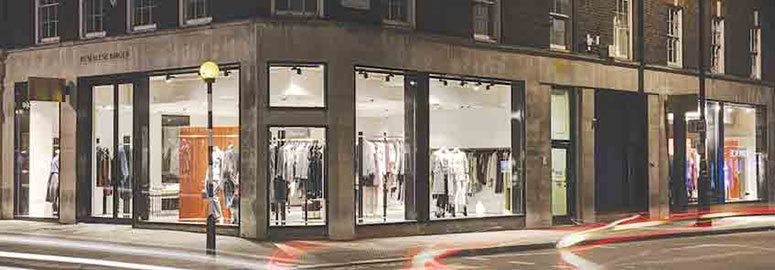
The Howard de Walden Estate is the freehold owner of most of the buildings that shape 92 acres of Marylebone. It manages and leases properties across an area that extends from Marylebone High Street in the west to Portland Place in the east and from Wigmore Street in the south to Marylebone Road in the north.
The entire estate is worth about £4bn, with residential (£1.2bn) accounting for the biggest share by value. Offices, retail, schools, educational and hotels all feature prominently but with Harley Street still perhaps the best-known real estate in the portfolio, by income, medical is now the most valuable. It earns the estate about £34m a year.
“That has grown exponentially and, on the basis of prelets and other demand, it will continue,” says Hynard. “And we’re very happy with that number, I don’t think we want to get it much more than perhaps 40% at the top but while we’re not diversified in geographical location, the diversity we get is through the uses.”
As a family business, Lord Howard de Walden’s daughters are all non-executive directors and sit on the board.
“They feel very strongly on certain aspects, such as the building that we’re in, 23 Queen Anne Street, which their father was instrumental in developing, but they have absolutely devolved the running of the business to the board and the management,” says Hynard.
“There’s a big annual day out – we close the office and the family come along. There’s an annual general meeting, which we present to the beneficiaries and we do family tours and so on. So they’re involved but in, from my perspective, a delightfully sort of hands-off way. And they’re very, very supportive.”
Main image: © Radharc Images/Alamy/Stock Photo
To send feedback, e-mail damian.wild@egi.co.uk or tweet @DamianWild or @estatesgazette







